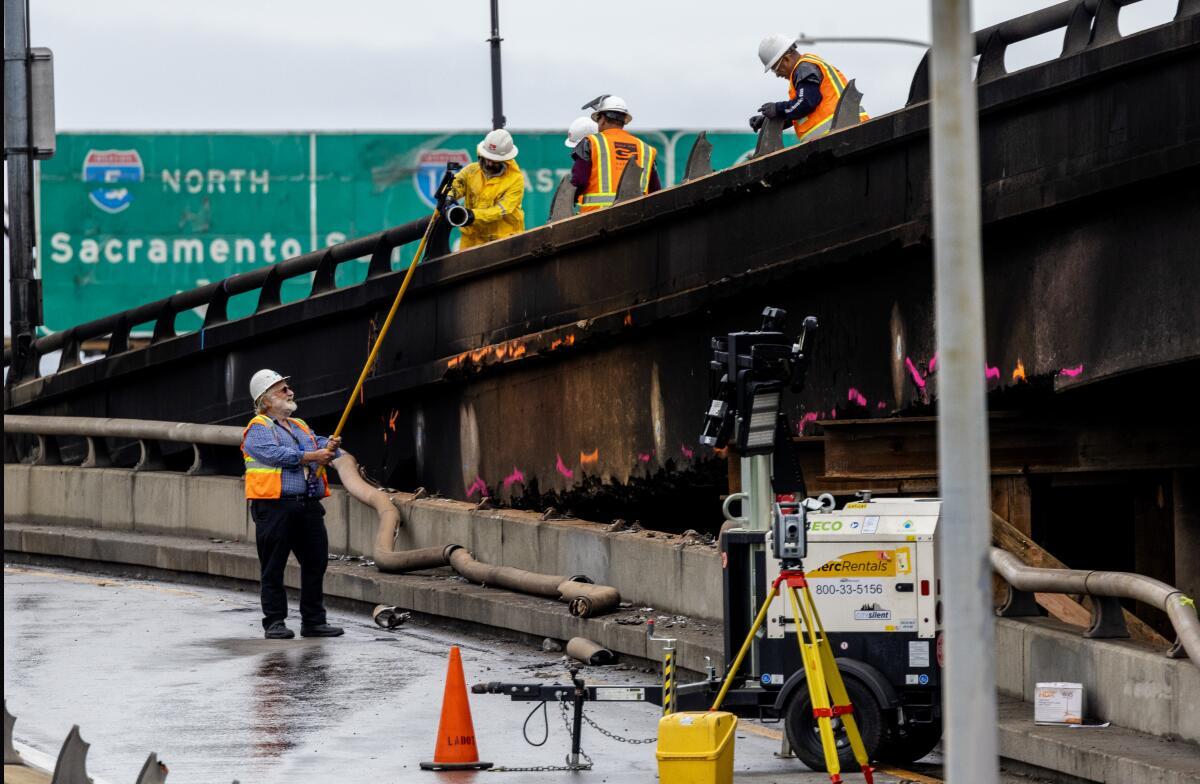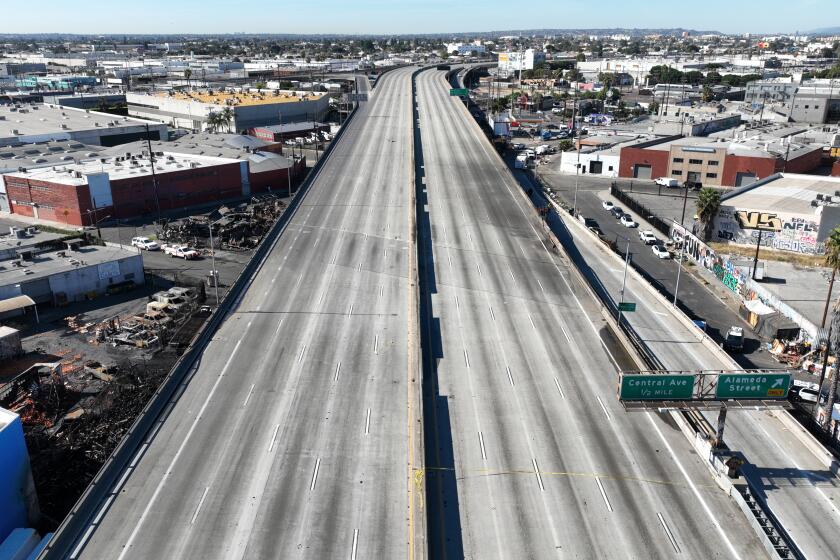Editorial: The 10 Freeway was fixed in days. Why can’t more transportation projects get fast tracked?

- Share via
Don’t let anybody tell you California can’t move fast on transportation construction. Gov. Gavin Newsom said that the section of the 10 Freeway damaged by a pallet fire will reopen Monday morning, if not sooner — a little over a week after the blaze severely damaged the overpass.
Initially, officials warned that the freeway could be closed for weeks or months, but the bridge structure was in better shape than anticipated. Still, the repair work has moved with extraordinary speed, and it shows what is possible when leaders put their energy, organizations and funding toward delivering quick results.
The freeway shutdown shows the car is still king in Los Angeles. This is a moment to expand transit services to help commuters now and encourage people to keep using buses and trains after the route reopens.
So, why can’t more transportation projects get the speedy treatment? Although the work being done on the 10 Freeway is a model of expediency, other important transportation repair jobs have taken far longer to complete.
Take for example the rail line used by Amtrak’s Pacific Surfliner and Metrolink between Orange and San Diego counties. It’s the second busiest passenger route in the country, but was out of service for six months from late 2022 to early 2023 after a landslide and coastal erosion undermined the tracks.
It’s taken a year in some cases to repair storm-damaged bike paths in Los Angeles, leaving those routes closed to riders and forcing them onto busy streets, noted Michael Schneider, founder of the road safety advocacy group Streets for All.
If California wants people to drive less to cut planet-warming emissions, the state should be spending far more money on pedestrian, bike and transit projects.
And when it comes to new transportation projects, well, don’t hold your breath. Metro has been planning to build a busway on Vermont Avenue for nearly a decade, and it still isn’t slated for completion until 2027. California’s high-speed rail project, which was approved by voters in 2008, won’t have its first segment in operation until 2030. And there are countless other valuable projects that are moving at a snail’s pace because of red tape and funding delays.
Of course, new projects take longer than repair projects, and some repairs are more complicated and take more time to complete. (Highway 1 through Big Sur is still closed after storm damage in January.) The point is not that Californians should expect every transportation project to be completed in weeks or months or even a few years. But rather, the frenzy to fix the 10 demonstrates how government agencies can move fast when there is the opportunity and political will.
Transportation experts argue that congestion pricing is the rare silver-bullet solution to excessive traffic, but the U.S. has been slow to embrace it.
Within hours of the fire under the freeway, Newsom proclaimed a state of emergency, which allowed agencies to bypass bureaucracy and permitting, access emergency funding and offer private contractors financial incentives if they complete the work faster.
Newsom and Mayor Karen Bass were on scene with promises to work across local, state and federal agencies to get the route reopened as fast as possible. Bass gave daily briefings and stepped up public transit options for commuters. The California Department of Transportation set up a command center on site to coordinate the work, and construction crews have been working 24/7. And the federal government gave Caltrans $3 million in “quick release” emergency funds, money that is available only for freeways and bridges. That kind of immediate federal assistance is not available for rail and other transportation projects, state officials said.
The model of interagency coordination, on-the-ground leadership, cutting red tape and fast funding has worked before — look at Interstate 95 in Philadelphia, which reopened 12 days after it collapsed earlier this year.
But it should not be reserved only for the rare freeway catastrophe. There are countless other transit, pedestrian and safe-streets projects that deserve a similar sense of urgency. Transportation is the state’s biggest source of planet-warming emissions. Rapidly building our transportation system to make it easier and faster for people to get around without a car, while also expanding the electric vehicle charging network, will help address the longer-term catastrophe of climate change.
More to Read
A cure for the common opinion
Get thought-provoking perspectives with our weekly newsletter.
You may occasionally receive promotional content from the Los Angeles Times.













